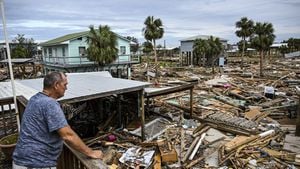A leisurely hike near Yellowstone Lake turned perilous for an 83-year-old woman from South Carolina when a bison charged and gored her, causing serious injury. This incident highlights the good and bad of human encounters with wildlife in national parks.
On June 1, the woman was exploring the Storm Point Trail, a serene path with captivating vistas of Yellowstone Lake. This tranquility was shattered when a nearby bison, feeling threatened, decided to protect its territory. The bison charged and lifted the woman nearly a foot off the ground using its horns, causing serious injuries. Retrieving her to safety, park emergency responders promptly transferred her to Eastern Idaho Regional Medical Center for urgent medical attention.
Bison, the largest land mammals in North America, are often perceived as docile, almost languid creatures as they graze in wide-open fields. This incident provides a stark reminder that these majestic animals can turn defensive and aggressive when provoked or feeling threatened. Bison are incredibly agile and can run three times faster than humans, a startling fact for many who visit the park each year.
Yellowstone National Park, established as the first national park in 1872, attracts millions of visitors annually, eager to witness its geysers, hot springs, and vibrant wilderness. The park houses a variety of wildlife including bison, elk, bears, and wolves. While this biodiversity enriches the visitor experience, it brings inherent risks.
Encounters with wildlife—particularly bison—are more common than most realize. Bison injuries happen more frequently in Yellowstone than any other animal-related incidents. Despite their seemingly placid nature, bison are unpredictable. They are affectionate towards their kin and protective of their space, showing aggressive behavior if humans inadvertently encroach too closely.
Park authorities enforce stringent guidelines aimed at safeguarding both human visitors and wildlife. They recommend keeping a distance of at least 25 yards from all large animals and 100 yards from bears and wolves. Despite these clear guidelines, accidents like the one on June 1 continue to occur, often due to a lack of awareness or disregard for these recommendations.
Instances like these prompt a wider discussion about human and wildlife coexistence. The National Park Service advocates that visitors heed to safety regulations and be acutely aware of their surroundings. Visitors are urged to move away if wildlife approaches and to stay vigilant, noting that wild animals can be defensive, especially during calving season or when paired with offspring.
Notably, this event raises important conversations in the realm of wildlife behavior and human impact on natural habitats. Scientists studying wildlife-human interactions in national parks have observed a spectrum of bison responses to human presence. Some bison display curiosity, while others exhibit clear signs of distress and defensiveness.
Preventive measures are crucial. For instance, interpretive education at park visitor centers includes briefings on wildlife behavior and safety practices. Additionally, physical barriers at heavily trafficked areas aim to funnel human activity away from bison feeding grounds.
Bison populations teetered on the brink of extinction at the turn of the 20th century, primarily due to unregulated hunting and habitat loss. Conservation efforts have since played a pivotal role in repopulating these keystone species in their native ranges. Yellowstone now hosts one of the largest wild bison populations, estimated to be around 5,000 individuals.
This incident invites a deeper examination of the broader implications behind human-wildlife interactions in protected areas like national parks. Policy-makers, conservationists, and park management constantly balance the desire for public access with the overarching goal of preserving the natural ecosystem.
Looking forward, enhanced educational outreach and stricter enforcement of safety measures could help mitigate future incidents. Continued research into the behavioral ecology of bison can inform park management practices, ultimately ensuring both human safety and animal welfare.
Future strategies may encompass more robust public engagement initiatives like mandatory safety workshops for intending park-goers. There’s a growing consensus that understanding and predicting animal responses through research will be key to devising non-intrusive methods of human-wildlife coexistence.
While this bison encounter serves as a poignant reminder of the inherent unpredictability of wildlife, it prompts us to reflect on the vital need for awareness, education, and respect in preserving the delicate balance of natural parks.



